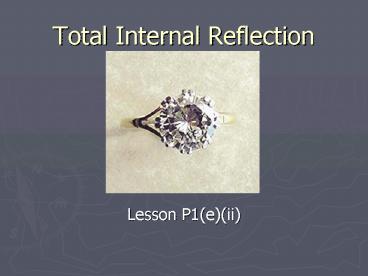Total Internal Reflection - PowerPoint PPT Presentation
1 / 19
Title:
Total Internal Reflection
Description:
Some is refracted across the boundary. Some will be reflected back into the slower medium ... bluish sky being strongly refracted by the hot air near the ... – PowerPoint PPT presentation
Number of Views:98
Avg rating:3.0/5.0
Title: Total Internal Reflection
1
Total Internal Reflection
- Lesson P1(e)(ii)
2
When light crosses a boundary into a faster
medium (e.g. glass to air)
- Some is refracted across the boundary
- Some will be reflected back into the slower
medium - The larger the angle of incidence, the bigger
proportion on the light is reflected
NORMAL
Fast medium
Slow medium
3
(No Transcript)
4
- If the angle of incidence reaches the critical
angle, the light is refracted at 900 i.e. along
the boundary - If the angle of incidence is greater than the
critical angle, no light is refracted it is all
reflected back in. - This is TOTAL INTERNAL REFLECTION
5
(No Transcript)
6
(No Transcript)
7
Total internal reflection in water if you looked
along the bottom ray you would not be able to see
out of the water!
8
Turning light through 90 0 using a prism
9
Turning light through 180 0 using a prism
10
A periscope can use prisms instead of mirrors
Note that the critical angle for glass must be
less than 45 0
11
Diamonds achieve their brilliance partially from
total internal reflection. Diamonds have a very
small critical angle only about 25 0
Incident light therefore strikes many of the
internal surfaces before it strikes one at less
than 25 degrees and emerges. After many such
reflections, the colours in the light are
separated, and seen individually.
12
This shows how light can be trapped
13
(No Transcript)
14
Fibre optics are a very important application of
total internal reflection
15
The light reflects its way down the light pipe
Hardly any light is lost this means that signal
sent this way need very little boosting
16
They also look very pretty!
17
Fibre optic cables are also used in medicine
Surgeons can perform key-hole operations
Endoscopes make it possible to see inside our
bodies
18
Mirages
19
When we view an inferior-mirage "water pool" on a
road or desert or other hot surface, what we are
actually seeing is the image of the bluish sky
being strongly refracted by the hot air near the
surface so that it appears to our mind to be
water lying on the surface































